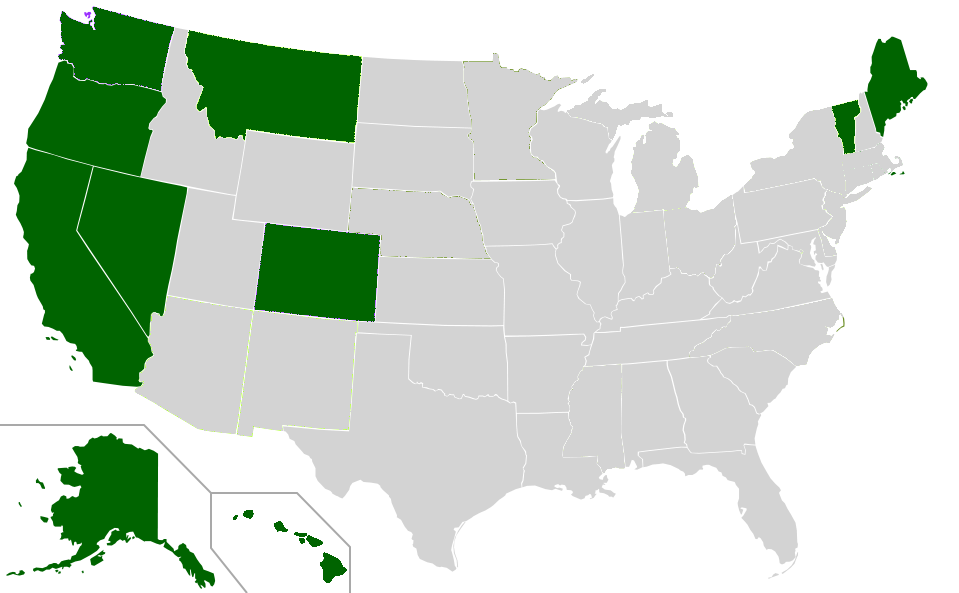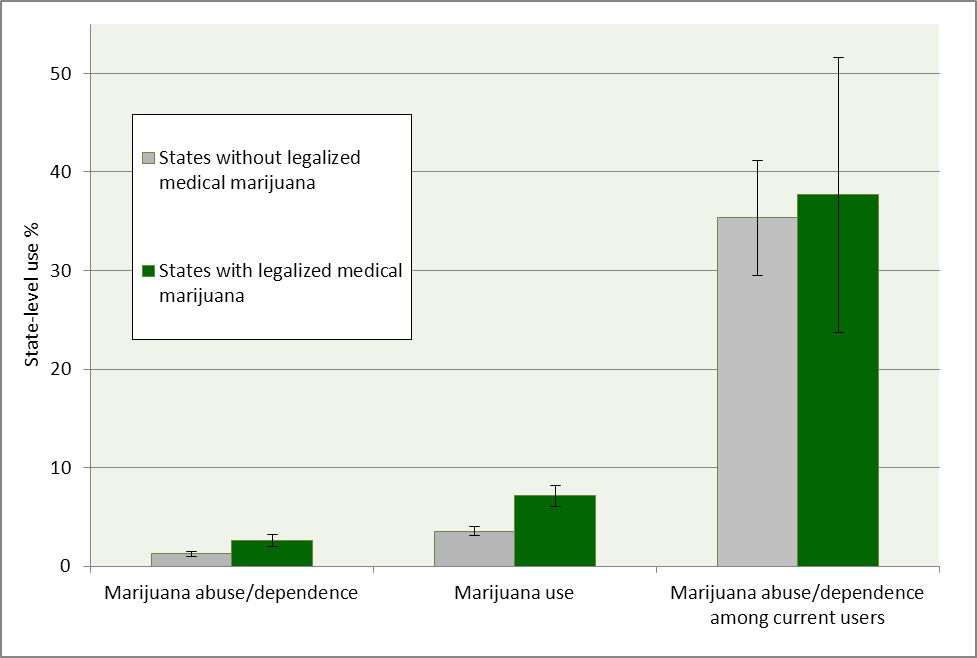STASH, Vol. 8(10) – A mile higher: Do medical marijuana laws predict marijuana use?
The legal landscape of marijuana legislation has changed drastically in last decade with many states passing medical marijuana laws, decriminalizing small quantities of marijuana, or outright legalizing the use of marijuana. It is unclear how these laws might affect marijuana use and related problems. This week’s STASH reviews a study that examines how marijuana use and abuse/dependence differ in states with and without medical marijuana laws (Cerda, Wall, Keyes et al., 2012).
Figure. States with legalized medical marijuana laws in 20041 Click image to enlarge.
Methods
- The primary exposure variable was whether states had legalized medical marijuana use by 2004 (Figure 1).
- For outcome data, the researchers used Wave 2 data from the National Epidemiologic Survey on Alcohol and Related Conditions (NESARC) which gathered data on marijuana usage and problems using face-to-face interviews during 2004-2005 (n=34,653) (Grant, Stinson, Dawson et al., 2004).
- Researchers administered the Alcohol Use Disorder and Associated Disabilities Interview Schedule-DSM-IV Version (AUDADIS-IV) which covers past-year non-medical marijuana use2 and symptoms of abuse/dependence (Grant, Dawson, Stinson et al., 2003).
- The three outcome variables were (1) prevalence of past-year non-medical marijuana use among the general population, (2) prevalence of past-year marijuana abuse/dependence3 among the general population, and (3) prevalence of marijuana abuse/dependence among past-year users.
- The researchers used a state-level linear regression model predicting the prevalence of marijuana use and abuse/dependence from medical marijuana laws, adjusting for demographic variables (e.g., proportions of residents who are male, without a high school diploma, and under age 30).
- They also used a multilevel logistic regression model predicting individual marijuana outcomes from both individual covariates and state-level covariates (including medical marijuana law).
Results
- Figure 2 represents the findings of the state-level analysis.
- The rate of past-year non-medical marijuana use was higher in states with medical marijuana use laws (7.13%, 95% CI = 6.02, 8.24) than in states without these laws (3.57%, 95% CI = 3.10, 4.03)(p<0.01)
- The prevalence of marijuana abuse/dependence was also higher in states with medical marijuana use laws (2.61%, 95% CI = 1.96, 3.25) than in states without these laws (1.27%, 95% CI = 1.00, 1.54) (p<0.01).
- However, marijuana abuse/dependence among past-year users did not differ significantly between states with and without medical marijuana use laws (37.68% and 35.34%).
- The multilevel analysis revealed that residents in states with medical marijuana laws were 1.92 (95% CI = 1.49, 2.47) times more likely to have used marijuana in the past year and 1.81 (95% CI = 1.22, 2.67) times more likely to experience marijuana abuse/dependence. However, living in a state with legalized medical marijuana did not increase risk for marijuana abuse/dependence among past-year users (OR = 1.03, 95% CI = 0.67, 1.60).
Figure. Regression-adjusted mean prevalence and 95% confidence intervals for past-year outcomes in states with and without legalized medical marijuana. Click image to enlarge.
Limitations
- The study does not examine the causal relationship between the passage of medical marijuana legislation and marijuana use behavior. While it is possible that medical marijuana legislation encourages non-medical marijuana use, another possibility is that higher rates of marijuana use contribute to the passage of medical marijuana legislation. Other causal pathways are possible.
- This study does not consider how marijuana use changes over the span of time after the laws are enacted.
Conclusions
The study shows that the states with medical marijuana laws have a higher rate of marijuana use and abuse/dependence among the general population than other states. However, these relationships were not evident among past-year users. This suggests that the higher rates of marijuana abuse/dependence in states that have legalized medical marijuana can be explained by a higher rate of marijuana use. The passage of medical marijuana laws might contribute to increased use by changing norms about the safety and acceptability of marijuana use. A longitudinal study that included measures of attitudes and beliefs, not just marijuana use, would be needed to address this possibility.
-Jed Jeng
What do you think? Please use the comment link below to provide feedback on this article.
References
Cerda, M., Wall, M., Keyes, K. M., Galea, S., & Hasin, D. (2012). Medical marijuana laws in 50 states: Investigating the relationship between state legalization of medical marijuana and marijuana use, abuse and dependence. Drug and Alcohol Dependence, 120(1-3), 22-27.
Grant, B. F., Dawson, D. A., Stinson, F. S., Chou, S. P., Ward, K., & Pickering, R. P. (2003). The Alcohol Use Disorder and AssociatedDisabilitiesInterviewSchedule-IV (AUDADIS-IV): reliability of alcohol consumption, tobacco use, family history of depression and psychiatric diagnostic modules in a general population sample. Drug and Alcohol Dependence, 71(1), 7-16.
Grant, B. F., Stinson, F. S., Dawson, D. A., Chou, S. P., Dufour, M. C., Compton, W., et al. (2004). Prevalence and Co-occurrence of Substance Use Disorders and IndependentMood and Anxiety Disorders. Archives of General Psychiatry, 61(8), 807-816.
________________
[1] Modified from Map of US state cannabis laws by Lokal_Profil (CC BY-SA 2.5)
[2] The AUDADIS-IV covers cannabis use, but the authors note that the proportion of non-marijuana cannabis use is very small (~1%)
[3] Researchers combined marijuana abuse and dependence diagnoses into one outcome variable

